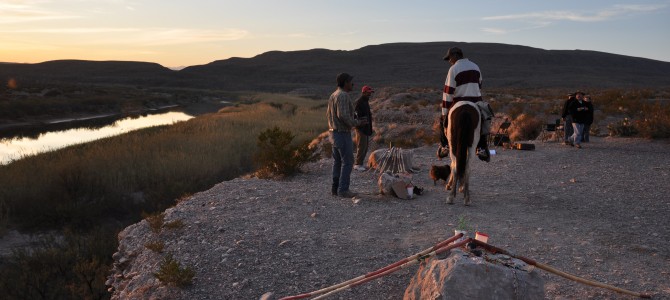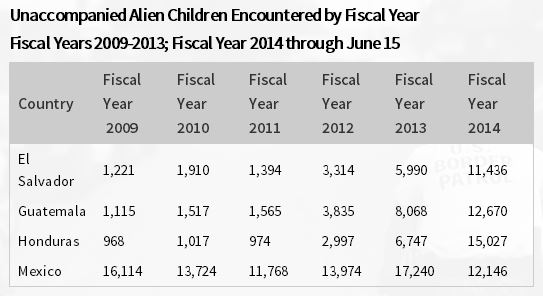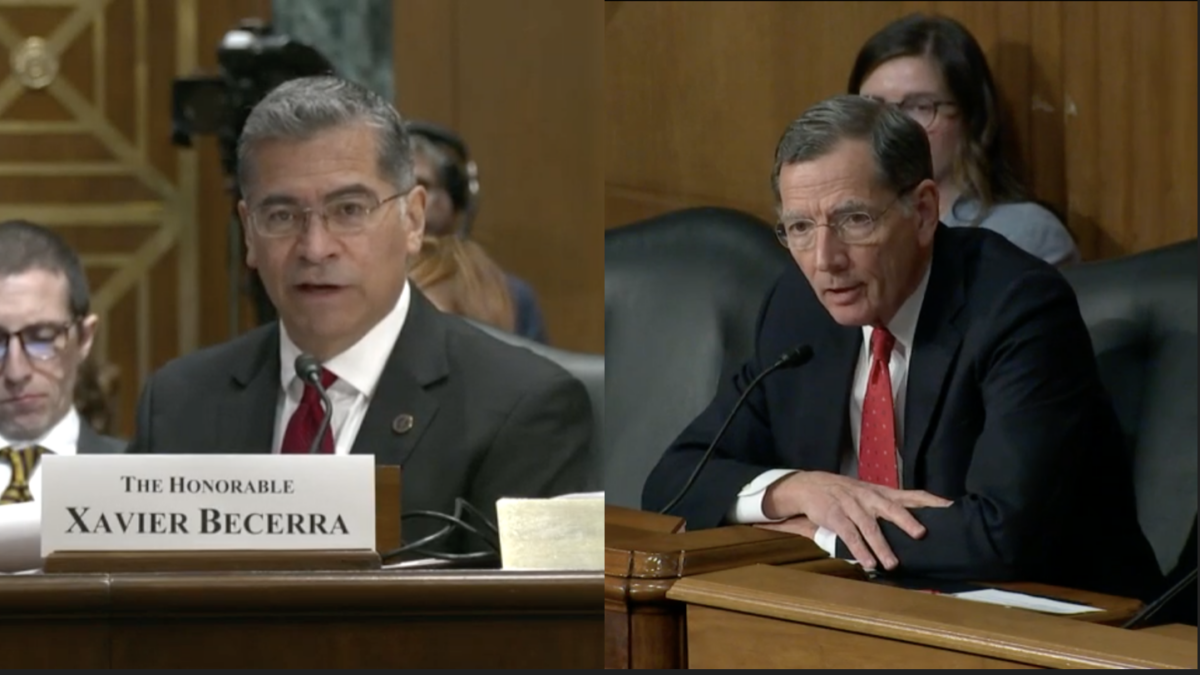
Explanations of the immigration crisis unfolding in Texas fall roughly into two categories: violence and poverty in Central America have prompted tens of thousands of people to flee their homes and seek illegal entry into the United States via Mexico, or the Obama administration is to blame for neglecting the border and giving the impression that children and youth entering the country illegally will not be deported.
The first view is, of course, the one espoused by the administration. Homeland Security Secretary Jeh Johnson told the Senate Judiciary Committee as much last week: “Violence, poverty—I believe that is principally what is motivating the situation.”
Johnson has a point. Most of those apprehended at the border have traveled from Guatemala, Honduras, and El Salvador. According to U.S. Border Patrol stats, the number of “unaccompanied alien children encountered” from those countries has dramatically increased in recent years, far outpacing those coming from Mexico.
It’s not hard to see why. Honduras has the highest homicide rate in the world, while Belize, El Salvador, and Guatemala have the third, fourth, and fifth highest, respectively. Although it can be difficult to get accurate English-language news reports from Central America, some Spanish-language news outlets have noted a recent spike in gang-related violence—and in this context, “gang violence” is akin to terrorist attacks or conflicts between armed militias.

The second view, that the surge of children and youth at the border is a direct result of Washington politics, is the one held by conservatives who want to pin blame for the crisis on the White House. They argue the administration’s June 2012 decision not to enforce immigration law against those who had been brought to the country illegally as children—the Deferred Action for Childhood Arrivals, or DACA—effectively signaled the United States would no longer deport illegal immigrants, even though the policy applies only to minors who have been in the United States continuously since 2007. The DACA scheme was meant to accomplish some of the goals of the failed DREAM Act, but as Erica Grieder at Texas Monthly notes:
In looking through Guatemalan and Honduran news reports about the program, though, you’ll notice that they rarely mention the fine print about which minors, exactly, are eligible. It’s not that hard to imagine how people could get the impression that the United States had decided not to deport children, or why parents in these desperately poor and crime-riddled countries would be motivated to act in response.
That’s consistent with what hundreds of U.S. Border Patrol interviews have revealed: Children and families came expecting to be issued a “permit” allowing them to stay, and that permits were being issued by the U.S. government only through the end of June. Hence, the sudden surge.
It’s Not An Either-Or, Folks
So which view is correct? Is the border crisis merely a result of endemic, worsening problems in Central America that are beyond our control, or did the Obama administration encourage—and even prepare for—a surge of illegal immigration for political reasons, hoping that a crisis of this kind might force Congress to pass comprehensive immigration reform that includes amnesty?
Both views are partially correct. Unprecedented numbers of Central Americans are risking their lives to get into the United States illegally because conditions in their home countries are nearly untenable, and getting worse. But they’ve also been led to believe they will not be deported. Some of the blame for that lies with the Obama administration, but not all of it.
Smugglers in Mexico are moving people into the United States for money. It’s a business proposition, and part of the smugglers’ scheme is to sell families on the idea that children and minors who get into the United States will not be deported. Mexican drug cartels are of course behind this scheme, and they’re pushing it because their traditional sources of income have become unstable.
I spoke with Roger Pardo-Maurer, the former top civilian official at the Pentagon for Western Hemisphere Affairs during the Bush administration, who said changing enforcement of U.S. drug laws for marijuana is cutting into profits and pushing the cartels to ramp up other activities: heroin sales, extortion, human trafficking—and now, the smuggling of children and teenagers into the U.S from Central America. In corporate parlance, they are diversifying their criminal portfolios.
Encouraging Criminals
In this context, the Obama administration’s tacit encouragement of illegal immigration bolsters the smugglers’ pitch to families that if their children can just get into the United States, they can stay. Parents in these countries are desperate. Faced with persistent poverty and violence, the promise of a better life for their children in the United States needs only the slightest official encouragement. The White House has provided it, however unwittingly.
Given the state of things in Central America, any solution to the immigration crisis on the border must involve addressing the root causes of societal decay in those countries. The Bush-era Merida Initiative sought to do just that by funding security assistance for Mexico, Honduras, El Salvador, and Guatemala, but the program was always too small to make a difference, and the Obama administration has neglected it.
More immediately, the White House can counter the widespread expectation in Central America that if your children get here, they can stay. Rhetoric really matters in this case, and a sustained public information campaign can do much to manage expectations and dissuade families that are otherwise susceptible to vague rumors and empty promises.
In the 1990s, rumors and misinformation prompted thousands in Haiti and Cuba to hazard sea voyages to the United States in hopes that if they just made it to shore they would not be deported. In response, the Clinton administration belatedly launched, and the Bush administration intensified, an aggressive media and public relations campaign about the dangers of illegal immigration that sought to leave no doubts about U.S. policy.
It worked—and it could work again if the Obama White House took immediate action to counter rumors and misinformation in Central America and to roll back the expectations it has helped create. After all, what’s happening in Texas is a real humanitarian crisis that could have been prevented. The least we can do now is set the record straight and try to limit the damage already done.
Unless, of course, this is what the administration was hoping for all along.
Follow John Davidson on Twitter.









